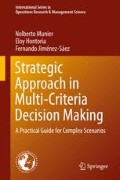Abstract
This chapter is mainly devoted to a critical task: modelling a scenario. It addresses two main aspects:
-
(a)
Elements of the IDM
-
(b)
How to model a scenario
Naturally, it is impossible in the second aspect to deal with the innumerable cases that correspond to a myriad of different projects and scenarios. The chapter aims at providing as much information as possible and as being a guide for the practitioner. It condenses conclusions from the examination of many cases proposed by researchers and practitioners around the world and using different methods and procedures. From here, the authors extracted critical aspects that should be considered. All these points lead to the formulation of a sound and realistic modelling that replicates a scenario as close as possible.
Access this chapter
Tax calculation will be finalised at checkout
Purchases are for personal use only
Notes
- 1.
Vilfredo Pareto. Italian engineer and economist.
- 2.
These references correspond to authors mentioned in the Text However, there are also publications than are not mentioned in the text but that have been added for the reader to Access more information about this Chapter; they are identified with (*).
References
These references correspond to authors mentioned in the Text However, there are also publications than are not mentioned in the text but that have been added for the reader to Access more information about this Chapter; they are identified with (*).
Al-Aomar R (2010) A combined AHP-Entropy method for deriving subjective and objective criteria weights. Int J Ind Eng 17(1):12–24
*Beasley J (2018) OR – Notes - http://people.brunel.ac.uk/~mastjjb/jeb/or/contents.html. Accessed 5 Feb 2018
Belton V, Gear AE (1983) On a shortcoming of Saaty’s method of analytic hierarchies. Omega 11:228–230
Cascales M-T, Lamata M-T (2012) On rank reversal and TOPSIS method. Math Comput Model 56(5–6):123–132
Dantzig G (1948) Linear Programming and extensions - R-366-PR- Corporation
Eppe S, De Smet Y (2015) On the influence of altering de action set on PROMETHEE’s II relative ranks. CoDE-SMG - Technical Report Series Technical Report No. TR/SMG/2015-002 March 2015 – Université Libre de Bruxelles
Felli J, Hazen G (1997) Sensitivity analysis and the expected value of perfect information. http://citeseerx.ist.psu.edu/viewdoc/download?doi=10.1.1.39.3737&rep=rep1&type=pdf- Accessed 5 Feb 2018
Greco S (2006) Multiple criteria decision analysis: state of the art surveys. University of Catania, Springer source
Hwang C, Yoon K (1981) Multiple attribute decision making: methods and applications, A State- of - the - Art survey. Springer, Berlin
Jansen B, De Jong J, Roos C, Terlaky T (1997) Sensitivity analysis in linear programming: just be careful! Eur J Oper Res 101(1):15–28
Kantorovich L (1939) Mathematical methods of organizing and planning production. Manag Sci 6(4):366–422. (1960).
*Li S (2010) Rank reversal in properties in multicriteria decision making models. Ph.D. Thesis, University of Birmingham
Maleki H, Zahir S (2013) A comprehensive literature review of the rank reversal phenomenon in the analytic hierarchy process. J Multi-Criteria Decis Anal 20(3–4):141–155
Mareschal B, De Smet Y, Nemery P (2008) Rank reversal in the PROMETHEE II method: some new results. Conference: Industrial Engineering and Engineering Management, 2008. IEEM 2008. IEEE International Conference
Munier N (2011a) Methodology to select a set of urban sustainability indicators to measure the state of the city, and performance assessment. Ecol Indic 11(5):1020–1026. https://doi.org/10.1016/j.ecolind.2011.01.006
Munier N (2011b) a. Tesis Doctoral - Procedimiento fundamentado en la Programación Lineal para la selección de alternativas en proyectos de naturaleza compleja y con objetivos múltiples- Universidad Politécnica de Valencia, España
Munier N (2015) The Z matrix applied to risk determination. Internal report- INGENIO-Universidad Politécnica de Valencia, España
Nijkamp P (1977) Stochastic quantitative and qualitative multicriteria analysis for environmental design. Papers of the Regional Science Association 39:175–199
Pomerol J-C, Romero S (2000) Multicriterion decision in management: principles and practice. Boston - Kluwer Academic Publishers, Boston
Saaty T (1987) Rank generation, preservation, and reversal in the analytic hierarchy decision process. Decis Sci 18:157–117
Saaty T, Sagir M (2009) An essay on rank preservation and reversal. Math Comput Model 46(5–6):930–941
*Saaty T, Vargas L (1984) The legitimacy of rank reversal. Omega 12(5):513–516
Shannon C (1948) A mathematical theory of communication. Bell Syst Tech J 27:379.423, 623.656
Shing Y, Lee S, Ghun S, Chung D (2013) A critical review of popular multi-criteria decision-making methodologies. Issues in Information Systems 14(1):358–365
Triantaphyllou E (2001) Two new cases of rank reversals when the AHP and some of its additive variants are used that do not occur with the multiplicative AHP. J Multicrit Decis Anal 10:11–25
Verly C, De Smet Y (2013) Some results about rank reversal instances in the PROMETHEE methods. Int J Multicrit Decis Mak 3(3):325–345
*Wang YM, Elhag TMS (2006) An approach to avoiding rank reversal in AHP. Decis Support Syst 42:1474–1480
Wang Y, Luo Y (2009) On rank reversal in decision analysis. Math Comput Model 49(5–6):1221–1229
*Wang X, Triantaphyllou E (2006) Ranking irregularities when evaluating alternatives by using some multi-criteria decision analysis methods. Handbook of industrial and system engineering. CRC Press/Taylor & Francis Group, Boca Raton
Zeleny M (1974) A concept of compromise solutions and the method of the displaced ideal. Comput Oper Res 1(3–4):479–496
*Zeleny M (1982) Multiple criteria decision making. McGraw-Hill, New York
Zopounidis C, Pardalos P (2010) Handbook of multicriteria analysis. Springer, Heidelberg
Alinezhad A, Amini A (2011) Sensitivity analysis on TOPSIS technique: the result of change in the weights of one attribute on the final ranking of alternatives. J Optimization Ind Eng 7:23–28
Author information
Authors and Affiliations
Rights and permissions
Copyright information
© 2019 Springer Nature Switzerland AG
About this chapter
Cite this chapter
Munier, N., Hontoria, E., Jiménez-Sáez, F. (2019). The Initial Decision Matrix (IDM) and Its Fundamental Role in Modelling a Scenario. In: Strategic Approach in Multi-Criteria Decision Making. International Series in Operations Research & Management Science, vol 275. Springer, Cham. https://doi.org/10.1007/978-3-030-02726-1_2
Download citation
DOI: https://doi.org/10.1007/978-3-030-02726-1_2
Published:
Publisher Name: Springer, Cham
Print ISBN: 978-3-030-02725-4
Online ISBN: 978-3-030-02726-1
eBook Packages: Business and ManagementBusiness and Management (R0)

